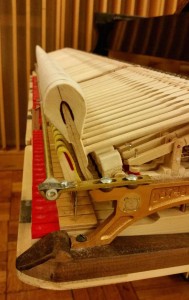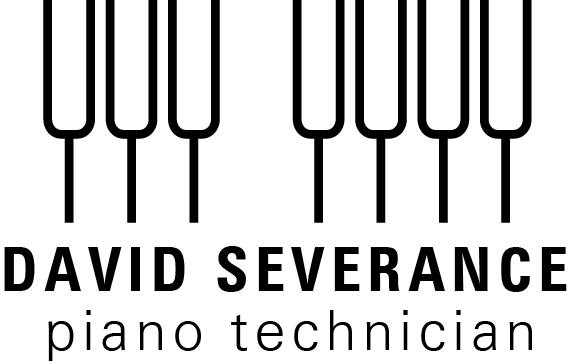Rebuilding includes all of the regulating steps, plus replacement of hammers, felts, dampers and other parts as needed to restore the instrument to its full potential.
The cost of rebuilding varies and will require a consultation for an estimate.
Call 208-798-9703 >

A new set of hammers, shanks and flanges installed on the Steinway D in Haddock Hall, Lionel Hampton School of Music, University of Idaho.
Rebuilding
Not all pianos are worth the expense of reconditioning or rebuilding. In consultation with your piano technician, you should consider the following factors:
- The overall condition of the piano. Can it really be restored to original condition or is it deteriorated beyond repair? Pianos subjected to severe fire, flood, or moving damage may not be repairable.
- The quality, size, and type of the piano. Low priced, small pianos of poor design have limited potential. If the rebuilt piano would not be capable of meeting your performance needs, it would be better to replace it with one of better design.
- The cost of repairs versus replacement. Major repairs may exceed the value of small low-quality pianos. However, most large high-quality instruments can be rebuilt for one-half to two-thirds the cost of a comparable new piano, making rebuilding a cost-effective option for fine pianos.
- Sentimental value. Personal attachment or historical value may justify investing in major repairs rather than replacement.
Rebuilding involves complete disassembly, inspection, and repair as necessary, including replacement of ALL worn, damaged, or deteriorated parts. This piano is then reassembled, tested, and adjusted to the same or similar tolerances as new. COMPLETE REBUILDING includes the entire pianos structure — including soundboard, bridges, pinblock, and strings — as well as the action, keyboard, and case refinishing. PARTIAL REBUILDING includes only one or two of these areas, for example rebuilding of the action and structure, but not case refinishing.
Rebuilding restores the piano to original condition or better. Such comprehensive work is usually most practical for high-quality instruments here maximum performance and longevity are required.
Complete rebuilding typically includes:
- Complete disassembly of the instrument.
- Repair or replacement of soundboard, bridges, and pinblock, as well as repair of any structural damage to the case.
- Replacement of all strings and tuning pins.
- Thorough restoration of action and damper system, including replacement of hammers, many action parts, springs, and most felt.
- Rebuilding of the pedal and trapwork system, including replacement of all worn felt, leather, and metal parts.
- Refinishing of case and plate, polishing or replating of all hardware, and replacement of all decals, felt trims, and rubber buttons.
- Complete action regulation, tuning, and voicing.
- Multiple tunings to stabilize new strings.
Most pianos can be played for many years without major repairs. However, the tone, touch, and appearance will continually decline with age. When regular maintenance such as cleaning, regulating, voicing, and tuning can no longer provide satisfactory performance, a piano may require reconditioning or rebuilding.
Exactly when a piano needs rebuilding or reconditioning depends on its original quality, the climate, usage, and performance requirements. One piano may need rebuilding after just twenty years, while another may need only reconditioning after fifty years. The best way to decide is to seek out a qualified piano rebuilder with the judgment, experience, and expertise to advise you on such an important decision. If your Registered Piano Technician does not offer rebuilding services, ask for referrals.
Prior to regulation, your technician will assess the condition of your instrument. If it has badly worn parts or if there has been corrosion or moth damage, the piano may not be able to be properly regulated without some repair or replacement of parts.
Reconditioning is the process of putting your piano back in good condition by cleaning, repairing, and adjusting your instrument for maximum performance with replacement parts only where specifically indicated. If you piano has deteriorated beyond simple reconditioning, it may need to be rebuilt.
Rebuilding involves complete disassembly, inspection and repair as necessary with replacement of all worn or deteriorated parts. The piano is then reassembled, tested and adjusted to the same or similar tolerance and performance as when it was new.
Your piano is a major investment which deserves to be protected through regular servicing by a qualified technician. Properly maintained, your piano will sound its best and give you and your family a lifetime of enjoyment.
